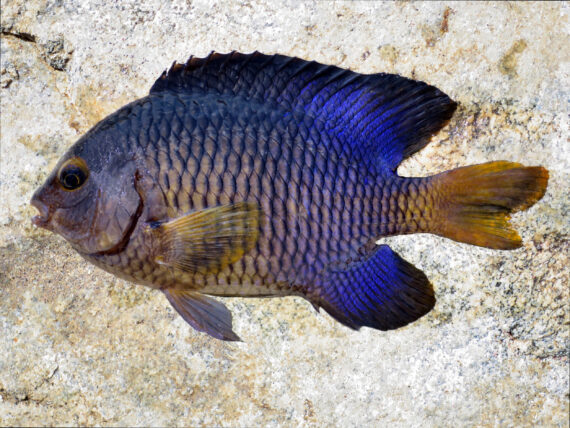Clarion Damselfish, Stegastes redemptus
 Clarion Damselfish, Stegastes redemptus. Fish caught from coastal waters of San José del Cabo Rió, Baja California Sur, April 2022. Length: 13.2 cm (5.2 inches). Catch, photograph and identification courtesy of Luke Ovgard, Klamath Falls, Oregon.
Clarion Damselfish, Stegastes redemptus. Fish caught from coastal waters of San José del Cabo Rió, Baja California Sur, April 2022. Length: 13.2 cm (5.2 inches). Catch, photograph and identification courtesy of Luke Ovgard, Klamath Falls, Oregon.
 Clarion Damselfish, Stegastes redemptus. Fish caught from the jetty at Cabo San Lucas, Baja California Sur, August 2020. Length: 16 cm (6.2 inches). Catch, photograph and identification courtesy of Eli (obsessiveangling.wordpress.com).
Clarion Damselfish, Stegastes redemptus. Fish caught from the jetty at Cabo San Lucas, Baja California Sur, August 2020. Length: 16 cm (6.2 inches). Catch, photograph and identification courtesy of Eli (obsessiveangling.wordpress.com).
The Clarion Damselfish, Stegastes redemptus, is a member of the Damselfish or Pomacentridae Family, that is also known as the Clarion Major and the Clarion Gregory and in Mexico as jaqueta azafranada. Globally, there are forty species in the genus Stegastes, of which eleven are found in Mexican waters, seven in the Atlantic and four in the Pacific Ocean.
The Clarion Damselfish has an oval compressed body with a depth that is 51% to 55% of standard length, similar in nature to freshwater bluegills. In adults, the head and the front half of the body are light brown in color, transitioning to darker brown with blue tinges extending into the anal and dorsal fins and then to a dark yellow brown. Their body scales have blackish margins and their anal fin and soft dorsal fin is whitish with pale yellow margins. Juveniles are light yellow anteriorly and dusky posteriorly, with a prominent dark spot at the rear of the dorsal fin and a smaller dark spot on the upper edge of the caudal base. Their head has a small protrusible mouth that opens in the front with a single row of teeth. Their anal fin has 2 spines and 12 to 14 rays; their caudal fin is bluntly forked; and their dorsal fin has 12 spines and 14 or 15 rays. They have 12 or 15 gill rakers that are long and close set. They are covered with large rough scales. Their lateral line is incomplete and terminates under the end of the dorsal fin base.
The Clarion Damselfish is found in shallow reefs within the surge zone, at depths up to 15 m (50 feet). They reach a maximum of 15.0 cm (5.9 inches) in length. They are diurnal omnivores that feed primarily on algae, benthic invertebrates and plankton. They are very aggressive with their feeding habits and when defending their territory. Reproduction is oviparous with pairing of individuals; eggs are distributed demersal and adhere to the substrate and are guarded by the males. The Clarion Damselfish is poorly studied with very limited information available about their lifestyle and behavioral patterns, including specific details on age, growth, longevity, movement patterns, diet, habitat use, and reproduction.
The Clarion Damselfish is a resident of all Mexican waters of the Pacific Ocean but is limited to the Revillagigedo Islands with a few fish found around the tip of the Baja in Baja California Sur.
The Clarion Damselfish can easily be confused with the Beaubrummel, Stegastes flavilatus (yellow-brown pelvic fins).
From a conservation perspective the Clarion Damselfish is currently considered to be Vulnerable which is attributed to their very limited range within the Revillagigedo Islands and related concerns about the negative impact of both El Niño and La Niña events. They are small in stature and of limited interest to most. They are classic nibblers, thus difficult to catch by hook and line.